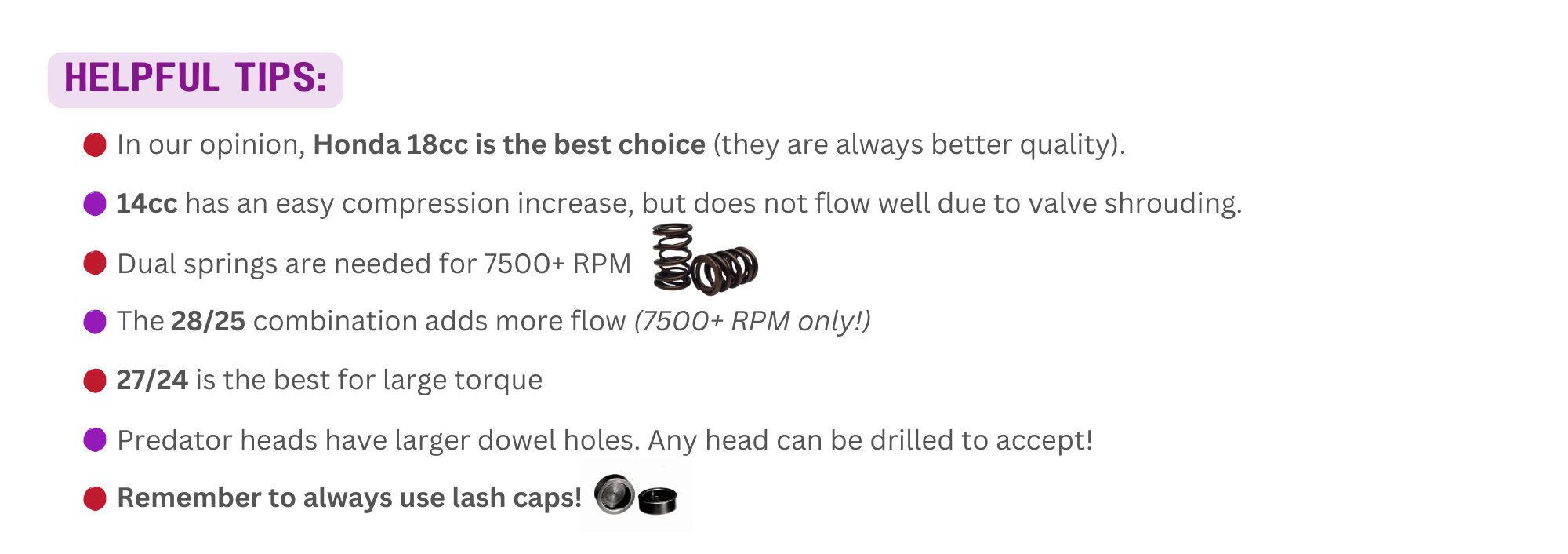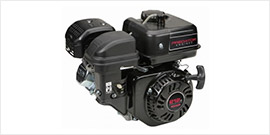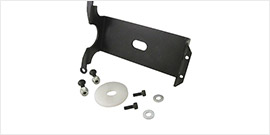Head Selection Guide.png) SMALL BLOCKS Our heads are:
They include:
Available heads for small engines:  Spring Selection:
Notes on 14cc versus 18cc Heads For flow improvement: as you mill the head, it removes part of the chamber and actually un-shrouds the valves. A 18cc head milled .080" has much better flow potential than an unmilled head. We say potential because edge treatment can affect the flow (i.e. round off the edges). We have a digital superflow bench and have flowed hundreds of heads in all kinds of different configurations with every type of porting one can imagine! We have backed up a lot of this with dyno testing (which does not always agree with the flow bench). In the end, unless major work is done to the chamber, the 18cc heads will always outflow the 14cc! The only advantage to a 14cc head is that the compression can be increased to around 10.3:1 by just bolting one on. You need to mill an 18cc head by .050" to achieve that. However, a .050" 18cc head can make more power than an un-milled 14cc head. Notes on Hemi Heads
Porting Comments The key to making power with a Honda head is mild porting, smoothing out the short side radius, blending the bowl, and shortening the valve guides by .100". Together, these will yield about 60% better flow than stock. Trying to remove any material (i.e. making the port larger) tends to hurt performance, and there is really not enough aluminum to do so. In fact, raising the floor of the port improves flow quite a bit. Honda ports – especially the exhaust – are intentionally oversized to promote cooling. The ports should also be left rough since this creates a boundary layer that improves flow. Sandblasting the ports after porting/smoothing helps considerably. This type of surface will flow much better than a polished surface; plus, it helps fuel atomization. The exhaust is not so critical since carbon buildup creates a rough surface on its own. Valve Size Comments A good three-angle valve job will allow up to 15% improvement in flow on a GX160/GX200 head. Unless running huge Mikunis or Tillys and turning 7000+ RPM, the stock valve sizes work very well and are capable of making up to 16+ HP. Stainless valves do flow a bit better than the stock valves. For high RPM operation (with big carbs and cams), the 27mm intake valve will help and will allow 18hp. A 28.5 intake will only show improvement above 7,500 RPM. WARNING: 32/28 valves are subject to seat failure! They should only be used in methanol applications. And, to be honest, the 28/25s make as much, if not more, power (the velocity is much better)! Like our small block heads, the big block heads are fully ported, bead blasted, and can be milled to increase compression. Again, we don't polish these since bead blasting provides a boundary layer that flows better than polishing. Lift versus Flow It is important to mention that actual flow through the head is also a function of valve lift. Needless to say, the more lift, the more flow. Note: higher lifts can decrease velocity, which in turn, decreases torque. For the most part, GX200s show improvement as lift is increased. However, on the flow bench, a GX160 race head (big valve, ported, milled) does not show any additional flow after about .350 lift. Dyno testing combos above .350 lift (e.g. .400 lift) has shown only minimal high RPM improvement, usually at some losses at the low end. Also, the Honda valve train does not do well with a lot of lift. There are a lot of geometry issues that one must address. 1.3 rockers should be avoided on high lift as they really play havoc on the geometry. We have seen many failures from using 1.3 rockers with big cams. You can get them to work, but custom valves, spring pockets, and other head work is needed. General Rule:
Notes on Milling You will need to mill the head to get to your desired compression ratio. It all depends on the piston, deck height, and gasket.
If unsure, mill to .050". BIG BLOCKS Big block heads include:
Available heads for big engines:
We also offer a Large Port, High RPM head, which uses large port castings to increase high RPM power at some loss of low-end torque and reduced throttle response. They can provide increased cooling for endurance applications. 390 heads will fit 340s, and 270 heads will fit 240s. |
Get 6 Months To Pay On Purchases of $99 or more with


